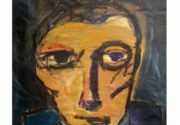The first time I saw Rula Halawani was in 1995, a little more than a year after the Oslo Accords. She had been accompanying Palestinian adolescents who were facing Israeli adolescents in a photography workshop organised by the International Center for Peace in the Middle East. The objectives of this workshop were to allow adolescents […]
ArteEast is excited to present the extraordinary paintings of Golnaz Fathi, a young artist living and working in Tehran. Her works are at once painterly explorations of color and form that integrate largely illegible calligraphy, as well as open-ended invitations to meditate on the silence and randomness that they often present. The viewers’ imagination is […]
On Nostalgic Longing and Monumentalism in Ghada Samman’s The Impossible Novel Ghada Samman’s collection of prose poems, Letters of Longing for Jasmine (1996), opens with the following passage: Everyone who masterfully conceals their emotions explodes like a deluge if they are exposed. Here I am revealing and writing about the projection of my […]
In recent years, Turkish cinema – be it produced by Turkish, European companies or joint ventures – has garnered more attention in international film festivals and competitions. Internationally recognized and awarded films by directors, such as Nuri Bilge Ceylan and Fatih Akin, have been instrumental in situating Turkish cinema within a European cultural arena. One […]
Beirut, in many ways, is an “Urbs Incognita,” a city that has been presented only through clichés. The euphoric expressions—“mosaic of communities,” “crossroads of cultures,” “Switzerland of the Middle East”—have been used and abused. Despite all this romanticising, this weary city seems condemned to be destroyed after each reconstruction by a new group of […]

Cardboard Untitled acrylic on paper 2004 Rafik Majzoub is a rising star in the Lebanese art scene, heading towards international recognition for his works which traverse the rich territory between the personal and the social. His paintings and larger scale conceptual pieces explore the many facets of this territory — including the arrogance of power, […]
Excerpted from Saloua Raouda Choucair: Her Life and Art, pp. 17-35, Catalogue raisonné (Beirut, Lebanon, 2002). Translated by Kirsten Scheid.[1] From the beginning, that is (as far as Saloua Raouda Choucair can recall of the young school-girl she was in the 1920s), from her very first contact with the age-old reigning concepts about […]
Excerpted and revised from Painters, Picture-makers, and Lebanon: Ambiguous Identities in an Unsettled State (Princeton University, 2005). A clear plastic bag, bursting with papers of various yellows and grays – this is what Saloua Raouda Choucair reached for in the cupboard next to her bed. She pulled out of it press reviews of her […]
When the heart has been broken, it cries out: Samarkand She is the partridge…. *** Can you not weep tomorrow? Perhaps I can But does this dew descend Whenever the road to Damascus finds me I gather this echo Just as the lovers gather the tears from the night I gather this echo Perhaps Perhaps […]
Artist/educator Mohammad Ehsai is one of the most renowned trendsetters in what is now called the art of calligraphic painting (Naghashi-khat) in the Middle East and specifically Iran. Rarely has the work of Mohammad Ehsai been discussed with an analytical eye or a refined method. Rather, his work has often been intellectually marginalized. By situating […]